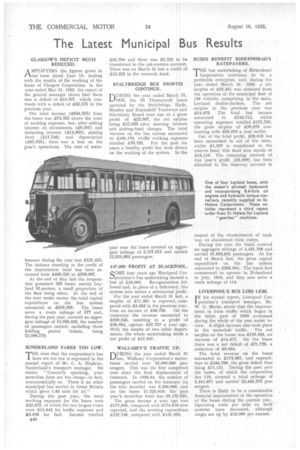The Latest Municipal Bus Results
Page 50

If you've noticed an error in this article please click here to report it so we can fix it.
GLASGOW'S DEFICIT MUCH REDUCED.
AMPLIFYLNG the figures given in our issue dated June 14, dealing with the results of the working of the buses of Glasgow Corporation in the year ended May 31, 1935, the report of the general manager shows that there was a deficit of £14,807, which contrasts with a deficit of £42,178 in the previous year.
The total income (044,628) from the buses was £74,355 above the total of working expenses, but, after adding interest on investments (£9,307) and deducting interest (£14,868), sinking fund (£17,746) and depreciation (£65,855), there was a loss on the year's operations. The cost of main
tenance during the year was £121,415. The balance standing to the credit of the depreciation fund has been increased from £446,328 to £509,667.
At the end of May last the corporation possessed 329 buses, mainly Leyland 51-seaters, a small proportion of the fleet being oilers. At the end of the year under review the total capital expenditure on the bus system amounted to £838,268. The buses serve a route mileage of 177 and, during the past year, covered an aggregate mileage'of 13,056,432, the number of passengers carried, excluding those holding period tickets, being 73,086,778.
SUNDERLAND FARES TOO LOW.
THE view that the corporation's bus fares are too low is expressed in the annual report of Mr. C. A. Hopkins, Sunderland's transport manager. He states: "Generally speaking, your anotorbus fares are too cheap—in fact, uneconomically so. There is no other municipal bus service in Great Britain which gives 1.83 mile for Id,"
During the past year, the total working expenses for the buses were £22,573, of which the two largest items were £12,942 for.traffic expenses and 43,978 for fuel. Income totalled B40 STALYBRIDGE BUS PROFITS CONTINUE.
DURING the year ended March 31, 1935, the 58 Thornycroft buses operated by the Stalybridge, Hyde, IVIossley and Dukinfield Tramways and Electricity Board were run at a gross profit of £23,987, the net surplus being £13,829 after meeting interest and sinking-fund charges. The total revenue on the bus system amounted to £100,179, whiltt working expenses totalled £76,192. For the past six years a healthy profit has been shown on the working of the system. In the
/47,000 PROFIT AT BLACKPOOL.
SOME four years ago Blackpool Corporation's bus undertaking showed a loss of £16,000. Reorganization followed and, in place of a deficiency, the system now makes a substantial profit.
For the year ended March 31 last, a surplus of £11,381 is reported, compared with £3,283 in the previous year, from an income of £96,735. On the tramways the revenue amounted to £330,246, resulting in a profit of £36,084, against £47,757 a year ago. With the results of two other departments, the whole undertaking made a net profit of £47,047.
WALLASEY'S TRAFFIC UP.
DURING the year ended March 31 last, Wallasey Corporation's motorbuses carried over 25,000,000 passengers. This was the first completed year since the final displacement of tramcars. In 1933-34, the number of passengers carried on the tramcars (in the nine months) was 3,356,089, and on the buses 21,220,919; the past year's motorbus total was 25,170,923.
The gross income a year ago was £177,506, compared with 2174,616 now reported, and the working expenditure £127,740, compared with £131,992, BUSES BENEFIT BIRKENHEAD'S RATEPAYERS.
THE bus undertaking of Birkenhead Corporation continues to be a profitable enterprise, and, during the year ended March 31, 1935, a net surplus of £32,251 was obtained from the operation of the municipal fleet of 135 vehicles, comprising, in the main, Leyland double-deckers. The net surplus in the previous year was £24,973. The total bus income amounted to £243,712, whilst operating expenses totalled £172,733, the gross surplus of £70,979 contrasting with £65,073 a year earlier.
Out of the total profit, £26,015 has been earmarked in aid of the rates, whilst £1,337 is transferred to the reserve fund; this fund now stands at £15,110. The remaining amount of this year's profit (£5,000) has been allocated to the tramway account in respect of the reinstatement of roadway on abandoned tram routes.
During the year the busescovered an aggregate mileage of 4,431,758 and carried 31,693,632 passengers. At the end of March last, the gross capital expenditure on the bus system amounted to 2265,994. The buses first commenced to operate in Birkenhead in July, 1919, and they now serve a route mileage of 114.
LIVERPOOL'S BUS LOSS LESS.
IN his annual report, Liverpool Corporation's transport manager, Mr. W. G. Marks, states that the improvement in tram traffic which began in the latter part of 1933 continued during the whole of the year under 'review. A slight increase also took place in the motorbiis traffic. The net surplus on the trams was £170,255, an increase of £14,817. On the buses there was a net deficit of £71,729, a reduction of £9,634.
The total revenue on the buses amounted to £173,587, and expenditure to £184,708, the gross deficit thus being £11,121. During the past year the buses, of which the corporation has 116, covered a total mileage of 3,341,671 and carried 23,446,273 passengers.
There is likely to be a considerable financial improvement in the operation of the buses during the current year. Operating costs per mile on both' systems have decreased, although wages are up by £16,000 per annum.




















































































